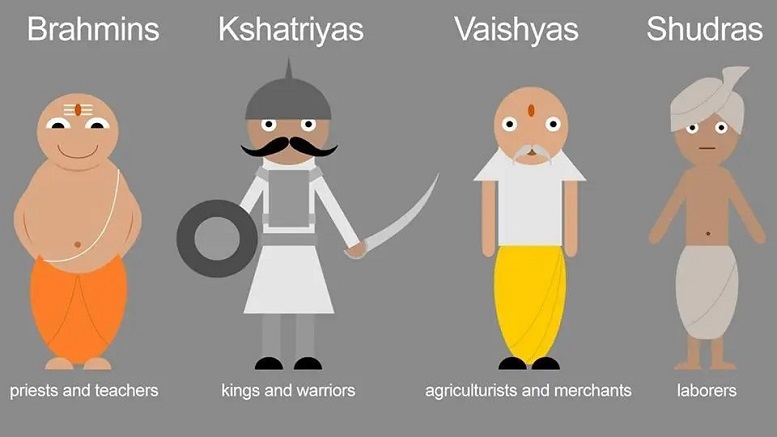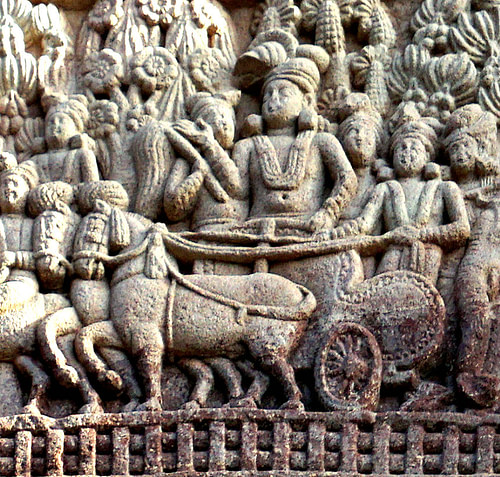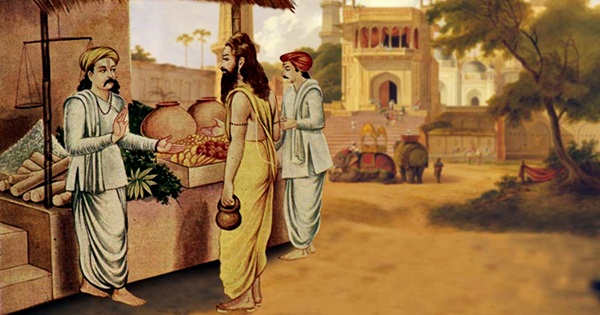
What is the Varna System?
The Varna System, originating from ancient Indian society, categorizes individuals into four groups based on their professions: Brahmins (priests and scholars), Kshatriyas (warriors and rulers), Vaishyas (merchants and traders), and Shudras (laborers and artisans). This classification aims to streamline societal functions by offering specialized recommendations to enhance proficiency within each group’s domain. By organizing individuals according to their skills and occupations, the Varna System facilitates efficient resource allocation and ensures the preservation and transmission of valuable knowledge across generations, contributing to societal stability and progress.
Why is Varna System Necessary?
The necessity of the Varna System lies in its role in ensuring the availability of specialized resources and knowledge to future generations. Through a stable mechanism of passing down quality skills and expertise from one generation to the next, each subsequent iteration can build upon the foundations laid by its predecessors, leading to continual improvements in various professions. This structured approach fosters expertise and innovation within each Varna, ultimately contributing to the overall advancement and well-being of society.

What is Varna Dharma?
Vrana Dharma embodies the belief that individuals can attain liberation or moksha through the dedicated and sincere practice of their chosen profession. It emphasizes the spiritual significance of fulfilling one’s duties and responsibilities within society, regardless of the specific Varna to which one belongs. By engaging wholeheartedly in their respective occupations and adhering to ethical principles, individuals can progress spiritually and contribute positively to the collective welfare of society, thereby fulfilling their Vrana Dharma.
Is Varna Hereditary?
The hereditary aspect of the Varna System, while prevalent in traditional societies, is not inherently necessary. While some individuals may choose to follow the occupations of their forefathers due to early exposure, familial knowledge, and established systems, the Varna System fundamentally revolves around an individual’s predisposition and interests rather than lineage. While hereditary continuity may offer certain advantages, such as familiarity and predictability, it is not a prerequisite for the effective functioning of the Varna System, which primarily aims to align individuals with professions suited to their abilities and inclinations.

A Look at the Varnas of Ancient Indian Society :
Brahman Varna: Non-commercial in nature the Brahmins are revered as the wise guardians of spiritual and moral knowledge. Their role centers on guiding individuals and communities towards spiritual enlightenment and ethical living. Through teaching and counseling, they impart ancient wisdom, fostering a deeper understanding of life’s purpose and moral principles. Brahmins uphold the sacred traditions and rituals that connect individuals to higher realms of consciousness. Their influence extends beyond religious ceremonies, as they serve as mentors and advisors, nurturing the spiritual growth of society. With their profound insights and teachings, Brahmins inspire individuals to lead virtuous lives and contribute to a more harmonious world.
Contributions to Society:
- Their dharma revolves around attaining spiritual enlightenment and assisting society through their detached wisdom and knowledge.
- They adhere to extreme discipline and austerities, often forgoing monetary payment, property ownership, and other material possessions.
- Survival often depends on minimal donations (bhiksha) from society, leading to a simple lifestyle characterized by basic facilities, modest clothing, and meager sustenance.
Mindset Required:
- Detachment from material desires
- Dedication to spiritual pursuits
- Compassion and empathy towards society
- Commitment to lifelong learning and self-improvement
Physical Appearance and Lifestyle:
- Modest attire made of undyed and unstitched cloth
- Simple living conditions with minimal possessions
- Physically frail due to extreme austerities, yet mentally elevated
- Often travel long distances on foot to serve the community
Sacrifices Made:
- Forgoing material wealth and comforts
- Living a life of simplicity and austerity
- Accepting societal limitations on financial sustenance
- Restricting family life to fulfill spiritual duties
Subcategories of Brahman Varna:
- Purohits (priests)
- Vaidyas (healers/physicians)
- Jyotishis (astrologers)
- Acharyas (teachers/scholars)
- Upadhyayas (spiritual instructors)
- Vedanta scholars
- Ritual specialists (tantriks)
- Philosopher-theologians (darshanikas)
Kshatriya Varna: Kshatriyas, known as the “immune system of society,” safeguard against threats and ensure prosperity for all. Their duty spans generations, focusing on preventing and combating internal and external dangers. Upholding law and order, they administer justice, lead in times of conflict, and foster societal growth. Trained in martial arts and governance, they balance military prowess with strategic planning. Marrying for political alliances, they manage households while upholding familial legacies. Kshatriyas exemplify duty, sacrifice, and leadership, embodying the essence of societal protection and prosperity for generations to come.
- Contributions to Society:
- Upheld law and order in society.
- Ensured protection from internal and external threats.
- Administered justice and maintained social order.
- Initiated political arrangements such as marriages and conquests for the kingdom’s benefit.
- Defended the kingdom through warfare and military prowess.
- Encouraged local economy through various schemes.
- Provided patronage to artists and artisans.
- Protected the vulnerable members of society through taxation redistribution.
- Mindset Required:
- Sense of duty towards maintaining societal order.
- Strong leadership qualities.
- Valour and courage in the face of adversity.
- Patriotism and loyalty to the kingdom.
- Willingness to make sacrifices for the greater good.
- Strategic thinking and decision-making skills.
- Physical Appearance, Habits, Lifestyle:
- Physically fit and trained in martial arts, weapon wielding, sports, and hunting.
- Rich and flavorful diet to maintain strength and energy.
- Consumption of meat and alcohol when necessary for maintaining morale.
- May spend extended periods away from home in war or distant lands.
- Strong presence and demeanor to instill confidence in their subjects.
- Women often engaged in political marriages and managed households with servants and attendants.
- Palaces served as symbols of prosperity and power rather than mere ego.
- Sacrifices Made:
- Risked their lives in battle and conflict.
- Spent significant time away from family and comforts during military campaigns.
- Endured harsh conditions and physical challenges.
- Faced the burden of decision-making and the consequences of their actions.
- Made personal sacrifices for the stability and welfare of society.
Subcategories of the Kshatriya Varna:
- Rajas (Rulers)
- Sena (Soldiers)
- Guptachara (Spies)
- Governors
- Administrators
- Law enforcement officials
- Military strategists
- Military commanders
- Martial arts trainers
- Weaponry experts

Brief Overview of the Vaishya Varna: Vaishyas, known as the “mover and shakers of the economy,” distinguish themselves from Shudras by operating businesses on a grand scale and with significant foresight. They excel in long-term financial planning and investments, often strategizing for business opportunities generations ahead. This community plays a pivotal role in economic growth, generating cash flow, and providing stable employment. Their visionary approach sets them apart, ensuring sustainability and prosperity for generations to come.
Contributions to Society:
- Business Owners: Provide essential goods and services, create job opportunities, contribute to economic growth through investments and entrepreneurship.
- Traders: Facilitate exchange and trade, bringing goods from distant lands, connecting regions economically and culturally.
- Large Scale Farmers: Ensure food security, supply essential agricultural products to the society, contribute to the economy through agricultural production.
- Dairy Farmers: Provide dairy products, contribute to nutrition and sustenance of the society.
Mindset Required:
- Entrepreneurial spirit: Willingness to take risks, innovate, and invest in ventures.
- Business acumen: Ability to manage finances, analyze markets, and make strategic decisions.
- Responsibility towards employees and society: Understanding the impact of their actions on others, striving for fairness and welfare of employees and community.
- Adaptability: Ability to navigate through market fluctuations, changes in demand, and external challenges.
Physical Appearance, Habits, Lifestyle:
- Varied physical appearance depending on individual lifestyles and regions.
- Often lived in excess, accumulating wealth in the form of land, gold, and luxurious possessions.
- Sedentary lifestyle due to administrative and managerial responsibilities.
- Overweight tendencies due to rich diet and less physical activity.
- Traders may have rugged appearance due to travel, exposure to harsh conditions, and the need to fend off threats.
Sacrifices Made:
- Time: Long hours dedicated to managing businesses, often at the expense of personal time and leisure.
- Financial risk: Investments made in ventures with uncertain outcomes, risking personal wealth.
- Social pressure: Constant need to maintain status, pay salaries on time, and handle envy from others.
- Physical safety: Traders facing dangers while traveling to distant lands, including encounters with bandits and harsh living conditions.
Subcategories of Vaishya Varna:
- Business Owners
- Traders
- Large Scale Farmers
- Dairy Farmers
Overview of Shudra Varna:
The Shudra varna is one of the four traditional social classes, or varnas, in Hindu society. They are primarily tasked with providing service to society and maintaining established systems in a consistent and reliable manner. Shudras typically lead routine-oriented lives, engaging in repetitive tasks with consistent quality and enthusiasm. They often enjoy a better work-life balance compared to other varnas, as they can disconnect from their responsibilities after work and engage in simple pleasures. Whether self-employed artisans, loyal employees, or dedicated service providers, Shudras find fulfillment in sincerely offering their chosen service without concerns beyond their immediate life.
 Given the vast diversity within the Shudra varna, comprising the largest percentage of the population and encompassing myriad occupations, the provided overview serves as a generalization. Variations in societal roles, contributions, and experiences are inevitable within this dynamic group. While the outlined characteristics offer insight into the typical attributes and responsibilities associated with Shudras, it’s essential to acknowledge the individuality and complexity within this varna. Each member, whether an employee, artisan, artist, or laborer, contributes uniquely to society, enriching the fabric of the community with their diverse talents and endeavors.
Given the vast diversity within the Shudra varna, comprising the largest percentage of the population and encompassing myriad occupations, the provided overview serves as a generalization. Variations in societal roles, contributions, and experiences are inevitable within this dynamic group. While the outlined characteristics offer insight into the typical attributes and responsibilities associated with Shudras, it’s essential to acknowledge the individuality and complexity within this varna. Each member, whether an employee, artisan, artist, or laborer, contributes uniquely to society, enriching the fabric of the community with their diverse talents and endeavors.
Contributions to Society:
- Service Provision: Shudras contribute to society by providing essential services in various sectors, ensuring the smooth functioning of communities.
- Maintenance of Systems: They play a crucial role in maintaining infrastructure, technology, and other systems vital for societal operation.
- Cultural Preservation: Artists and artisans within the Shudra varna contribute to the preservation of cultural heritage through their crafts and performances.
Mindset Required for Their Job:
- Dedication: Shudras need to be dedicated to their work, whether as employees or self-employed individuals, to ensure consistent service delivery.
- Commitment to Quality: They must maintain a high standard of workmanship or service quality to fulfill their dharma effectively.
- Adaptability: Being adaptable to different tasks and environments is essential for Shudras, given the diversity of roles within this varna.
Physical Appearance, Habits, and Lifestyle:
- Routine-Oriented: Shudras often lead routine-oriented lives due to the nature of their work, which involves repetitive tasks.
- Practical Dress: Their attire is typically practical and suited to their work environment, whether as office attire for employees or protective gear for artisans.
- Simple Lifestyle: They may lead simple lifestyles outside of work, focusing on basic pleasures and relaxation after fulfilling their duties.
Sacrifices Made:
- Limited Autonomy: Shudras may sacrifice autonomy in their work, particularly as employees following set schedules or as artisans catering to market demands.
- Time and Effort: They invest significant time and effort in mastering their craft or job, sometimes at the expense of personal pursuits.
- Financial Stability: In pursuit of their dharma, Shudras may prioritize stability over pursuing higher financial gains, opting for reliable employment or business ventures.
- Vulnerability to Replacement: The replaceability of Shudras in certain roles makes them more susceptible to exploitation. Therefore, they often need to work collectively in groups to negotiate better work conditions and fairer pay, enhancing their bargaining power and ensuring their rights are upheld. Subcategories of the Shudra Varna
Types of services:
- Employees:
- Those employed by businesses or government entities.
- Workers in various sectors such as agriculture, industry, and services.
- Self-Employed Individuals:
- Entrepreneurs running small businesses.
- Independent contractors providing various services like plumbing, carpentry, etc.
- Artists:
- Dancers.
- Poets.
- Singers.
- Actors.
- Artisans:
- Potters.
- Blacksmiths.
- Weavers.
- Carpenters.
- Craftsmen in various trades.
- Labourers:
- Agricultural labourers involved in farming activities.
- Construction workers contributing to infrastructure development.
- Domestic Help:
- Workers engaged in household chores, such as cooking, cleaning, and caregiving.
Brief Overview of Harijanas:
Harijans or Dalits, often referred to as “untouchables” in traditional Indian society, historically were assigned tasks considered polluting, such as waste disposal and other menial labor, with the belief that their dharma (duty) was to purify society by performing these jobs that others avoided.
The term “untouchable” is often misunderstood; in reality, Dalits played a crucial role in maintaining public health by handling waste disposal, thus preventing the spread of diseases. Their frequent exposure to filth led to an extraordinary level of immunity to various bacteria and viruses, giving them a unique resilience against illnesses. This biological advantage inadvertently led to societal practices of physical distancing from Harijanas, as other varnas recognized their susceptibility to diseases compared to the immune Dalit population.
Contributions to Society:
- Undertaking tasks considered impure or polluting, such as waste disposal and sanitation maintenance.
- Preventing the spread of diseases by managing waste effectively, leveraging their immunity to various pathogens.
- Fulfilling roles that are essential but often shunned by other members of society.
Mindset:
- Embracing the notion of dharma, or duty, to purify society through their labor.
- Accepting their societal role with resilience and a sense of purpose despite facing discrimination and marginalization.
Physical Appearance, Habits, Lifestyle:
- Often living in poverty with minimal material possessions.
- Engaging in physically demanding labor, leading to rugged physical appearances and robust health due to their unique immunity.
- Numbing their senses to endure the harsh realities of their work and social status.
Sacrifices they make:
- Enduring societal stigma and discrimination associated with their caste status.
- Facing health risks and hazards associated with their work, such as exposure to waste and pollutants.
- Foregoing opportunities for education and advancement due to systemic barriers based on caste discrimination.
Subcategories of the Harijanas:
- Sewer cleaners
- Doms (dead body burners)
- Other waste management workers (e.g., garbage collectors, scavengers)
- Modern-day industrial laborers, including factory workers exposed to radiation and chemicals
- Manual scavengers responsible for cleaning dry latrines and disposing of human waste
- Street sweepers and cleaners responsible for maintaining public sanitation
- Leather workers, traditionally associated with tanning and processing animal hides
In conclusion, every Varna plays a vital role in the smooth functioning of society, with each group contributing unique skills and perspectives. Recognizing and respecting the inherent strengths and weaknesses of each Varna is crucial for maintaining harmony and prosperity within society. By fostering mutual respect and cooperation among all Varnas, societies can harness the collective potential of its diverse members to address challenges and pursue collective progress.









